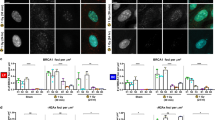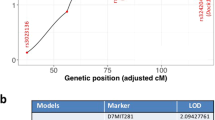Abstract
BRCA1 mutation carriers have an increased susceptibility to breast and ovarian cancer. Excision of exon 11 of Brca1 in the mouse, using a conditional knockout (Cre-loxP) approach, results in mammary tumor formation after long latency. To characterize the genomic instability observed in these tumors, to establish a comparative map of chromosomal imbalances and to contribute to the validation of this mouse model of breast cancer, we have characterized chromosomal imbalances and aberrations using comparative genomic hybridization (CGH), and spectral karyotyping (SKY). We found that all tumors exhibit chromosome instability as evidenced by structural chromosomal aberrations and aneuploidy, yet they display a pattern of chromosomal gain and loss that is similar to the pattern in human breast carcinomas. Of note, nine of 15 tumors exhibited a gain of distal chromosome 11, a region that is orthologous to human chromosome 17q11-qter, the mapping position of Erbb2. However, our analysis suggests that genes distal to Erbb2 are the main targets of amplification. Four of the tumors also exhibited a copy number loss of proximal chromosome 11 (11A-B), a region orthologous to human 17p. In eight of the tumors we observed whole or partial gain of chromosome 15 centering on 15D2-D3 (orthologous to human chromosome 8q24), the map location of the c-Myc gene, and six of the tumors exhibited copy number loss of whole or partial chromosome 14, including 14D3, the map location of Rb1. We conclude that despite the tremendous shuffling of chromosomes during the course of mammalian evolution, the pattern of genomic imbalances is conserved between BRCA1-associated mammary gland tumors in mice and humans. Western blot analysis showed that while p53 is absent or mutated in some tumors, at least two tumors revealed wild-type protein, suggesting that other genetic events may lead to tumorigenesis. Similar to BRCA1-deficient mouse embryonic fibroblasts, the tumor cells contained supernumerary functional centrosomes with intact centrioles whose presence results in multipolar mitoses and aneuploidy.
This is a preview of subscription content, access via your institution
Access options
Subscribe to this journal
Receive 50 print issues and online access
$259.00 per year
only $5.18 per issue
Buy this article
- Purchase on Springer Link
- Instant access to full article PDF
Prices may be subject to local taxes which are calculated during checkout





Similar content being viewed by others
References
Bacon CM, Tortolani PJ, Shimosaka A, Rees RC, Longo DL, O'Shea JJ . 1995 FEBS Lett. 370: 63–68
Barlund M, Tirkkonen M, Forozan F, Tanner MM, Kallioniemi O, Kallioniemi A . 1997 Genes Chromosomes Cancer 20: 372–376
Bieche I, Lidereau R . 1995 Genes Chromosomes Cancer 14: 227–251
Bochar DA, Wang L, Beniya H, Kinev A, Xue Y, Lane WS, Wang W, Kashanchi F, Shiekhattar R . 2000 Cell 102: 257–265
Deng CX, Brodie SG . 2001 Semin. Cancer Biol. 11: 387–394
Deng CX, Scott F . 2000 Oncogene 19: 1059–1064
Ghadimi BM, Schrock E, Walker RL, Wangsa D, Jauho A, Meltzer PS, Ried T . 1999 Am. J. Pathol. 154: 525–536
Gowen LC, Johnson BL, Latour AM, Sulik KK, Kollar BH . 1996 Nat. Genet. 12: 191–194
Hakem R, de la Pompa JL, Sirard C, Mo R, Woo M, Hakem A, Wakeham A, Potter J, Reitmair A, Billia F, Firpo E, Hui CC, Roberts J, Rossant J, Mak TW . 1996 Cell 85: 1009–1023
Hsu L-C, White RL . 1998 Proc. Natl. Acad. Sci. USA 95: 12983–12988
Khanna KK, Jackson SP . 2001 Nat. Genet. 27: 247–254
Liu CY, Flesken-Nikitin A, Li S, Zeng Y, Lee WH . 1996 Genes Dev. 10: 1835–1843
Liyanage M, Coleman A, du Manoir S, Veldman T, McCormack S, Dickson RB, Barlow C, Wynshaw-Boris A, Janz S, Wienberg J, Ferguson-Smith MA, Schrock E, Ried T . 1996 Nat. Genet. 14: 312–315
Ludwig T, Chapman DL, Papaioannou VE, Efstratiadis A . 1997 Genes Dev. 11: 1226–1241
Monni O, Barlund M, Mousses S, Kononen J, Sauter G, Heiskanen M, Paavola P, Avela K, Chen Y, Bittner ML, Kallioniemi A . 2001 Proc. Natl. Acad. Sci. USA 98: 5711–5716
Montagna C, Andrechek ER, Padilla-Nash H, Muller WJ, Ried T . 2002 Oncogene 21: 890–898
Nass SJ, Dickson RB . 1997 Breast Cancer Res. Treat. 44: 1–22
Phillips JL, Hayward SW, Wang Y, Vasselli J, Pavlovich C, Padilla-Nash H, Pezullo JR, Ghadimi BM, Grossfeld GD, Rivera A, Linehan WM, Cunha GR, Ried T . 2001 Cancer Res. 61: 8143–8149
Platzer P, Upender MB, Wilson K, Willis J, Lutterbaugh J, Nosrati A, Willson JK, Mack D, Ried T, Markowitz S . 2002 Cancer Res. 62: 1134–1138
Rhei E, Bogomolniy F, Federici MG, Maresco DL, Offit K, Robson ME, Saigo PE, Boyd J . 1998 Cancer Res. 58: 3193–3196
Ried T, Heselmeyer-Haddad K, Blegen H, Schrock E, Auer G . 1999 Genes Chromosomes Cancer 25: 195–204
Ried T, Just KE, Holtgreve-Grez H, du Manoir S, Speicher MR, Schrock E, Latham C, Blegen H, Zetterberg A, Cremer T, Auer G . 1995 Cancer Res. 55: 5415–5423
Schuyer M, Berns EM . 1999 Mol. Cell Endocrinol. 155: 143–152
Schuyer M, Henzen-Logmans SC, van der Burg ME, Fieret JH, Derksen C, Look MP, Meijer-van Gelder ME, Klijn JG, Foekens JA, Berns EM . 1999 Eur. J. Obstet. Gynecol. Reprod. Biol. 82: 147–150
Shen SX, Weaver Z, Xu X, Li C, Weinstein M, Chen L, Guan XY, Ried T, Deng CX . 1998 Oncogene 17: 3115–3124
Spector DL, Goldman RD, Leinwand LA . 1997 Cells: A Laboratory Manual. Cold Spring Harbor Laboratory Press
Tirkkonen M, Johannsson O, Agnarsson BA, Olsson H, Ingvarsson S, Karhu R, Tanner M, Isola J, Barkardottir RB, Borg A, Kallioniemi OP . 1997 Cancer Res. 57: 1222–1227
Tomlinson GE, Chen TT, Stastny VA, Virmani AK, Spillman MA, Tonk V, Blum JL, Schneider NR, Wistuba II, Shay JW, Minna JD, Gazdar AF . 1998 Cancer Res. 58: 3237–3242
Vaziri SA, Tubbs RR, Darlington G, Casey G . 2001 Mol. Pathol. 54: 259–263
Weaver ZA, McCormack SJ, Liyanage M, du Manoir S, Coleman A, Schrock E, Dickson RB, Ried T . 1999 Genes Chromosomes Cancer 25: 251–260
Wu GJ, Sinclair CS, Paape J, Ingle JN, Roche PC, James CD, Couch FJ . 2000 Cancer Res. 60: 5371–5375
Xu X, Qiao W, Linke SP, Cao L, Li WM, Furth PA, Harris CC, Deng CX . 2001 Nat. Genet. 28: 266–271
Xu X, Wagner KU, Larson D, Weaver Z, Li C, Ried T, Hennighausen L, Wynshaw-Boris A, Deng CX . 1999a Nat. Genet. 22: 37–43
Xu X, Weaver Z, Linke SP, Li C, Gotay J, Wang XW, Harris CC, Ried T, Deng CX . 1999b Mol. Cell. 3: 389–395
Zhong Q, Chen CF, Li S, Chen Y, Wang CC, Xiao J, Chen PL, Sharp ZD, Lee WH . 1999 Science 285: 747–750
Acknowledgements
The authors wish to thank Buddy Chen for manuscript editing, Joseph Cheng for IT-support and David L Spector for helpful discussions.
Author information
Authors and Affiliations
Corresponding author
Rights and permissions
About this article
Cite this article
Weaver, Z., Montagna, C., Xu, X. et al. Mammary tumors in mice conditionally mutant for Brca1 exhibit gross genomic instability and centrosome amplification yet display a recurring distribution of genomic imbalances that is similar to human breast cancer. Oncogene 21, 5097–5107 (2002). https://doi.org/10.1038/sj.onc.1205636
Received:
Revised:
Accepted:
Published:
Issue Date:
DOI: https://doi.org/10.1038/sj.onc.1205636
Keywords
This article is cited by
-
S100A9-CXCL12 activation in BRCA1-mutant breast cancer promotes an immunosuppressive microenvironment associated with resistance to immunotherapy
Nature Communications (2022)
-
Heterozygotic Brca1 mutation initiates mouse genome instability at embryonic stage
Oncogenesis (2022)
-
Dysregulated G2 phase checkpoint recovery pathway reduces DNA repair efficiency and increases chromosomal instability in a wide range of tumours
Oncogenesis (2021)
-
Molecular contribution of BRCA1 and BRCA2 to genome instability in breast cancer patients: review of radiosensitivity assays
Biological Procedures Online (2020)
-
Cyclin B1 stability is increased by interaction with BRCA1, and its overexpression suppresses the progression of BRCA1-associated mammary tumors
Experimental & Molecular Medicine (2018)



